
The Palace of Westminster is the meeting place of the Parliament of the United Kingdom and is located in London, England. It is commonly called the Houses of Parliament after the House of Commons and the House of Lords, the two legislative chambers which occupy the building. The palace is the centre of political life in the United Kingdom; "Westminster" has become a metonym for the UK Parliament and the British Government, and the Westminster system of government commemorates the name of the palace. The clock bell in the Elizabeth Tower of the palace, nicknamed Big Ben, is a landmark of London and the United Kingdom in general. The Palace of Westminster has been a Grade I listed building since 1970 and part of a UNESCO World Heritage Site since 1987.

Scotland Yard is the headquarters of the Metropolitan Police, the territorial police force responsible for policing Greater London's 32 boroughs. Its name derives from the location of the original Metropolitan Police headquarters at 4 Whitehall Place, which had its main public entrance on the Westminster street called Great Scotland Yard. The Scotland Yard entrance became the public entrance, and over time "Scotland Yard" came to be used not only as the common name of the headquarters building, but also as a metonym for the Metropolitan Police Service (MPS) itself and police officers, especially detectives, who serve in it. The New York Times wrote in 1964 that, just as Wall Street gave its name to New York's financial district, Scotland Yard became the name for police activity in London.
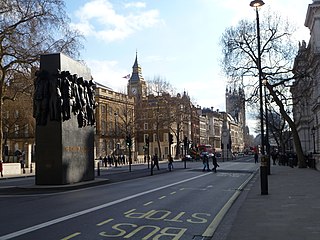
Whitehall is a road and area in the City of Westminster, Central London, England. The road forms the first part of the A3212 road from Trafalgar Square to Chelsea. It is the main thoroughfare running south from Trafalgar Square towards Parliament Square. The street is recognised as the centre of the Government of the United Kingdom and is lined with numerous departments and ministries, including the Ministry of Defence, Horse Guards and the Cabinet Office. Consequently, the name "Whitehall" is used as a metonym for the British civil service and government, and as the geographic name for the surrounding area.

The Palace of Westminster, the medieval royal palace used as the home of the British parliament, was largely destroyed by fire on 16 October 1834. The blaze was caused by the burning of small wooden tally sticks which had been used as part of the accounting procedures of the Exchequer until 1826. The sticks were disposed of carelessly in the two furnaces under the House of Lords, which caused a chimney fire in the two flues that ran under the floor of the Lords' chamber and up through the walls.

The Palace of Whitehall – also spelled White Hall – at Westminster was the main residence of the English monarchs from 1530 until 1698, when most of its structures, with the notable exception of Inigo Jones's Banqueting House of 1622, were destroyed by fire. Henry VIII moved the royal residence to White Hall after the old royal apartments at the nearby Palace of Westminster were themselves destroyed by fire. Although the Whitehall palace has not survived, the area where it was located is still called Whitehall and has remained a centre of the British government.

Portcullis House (PCH) is an office building in Westminster, London, England, that was commissioned in 1992 and opened in 2001 to provide offices for 213 members of the Parliament of the United Kingdom and their staff. The public entrance is on the Embankment. Part of the Parliamentary Estate, the building augments limited space in the Palace of Westminster and surroundings.

The House of Commons Library is the library and information resource of the lower house of the British Parliament. It was established in 1818, although its original 1828 construction was destroyed during the burning of Parliament in 1834.
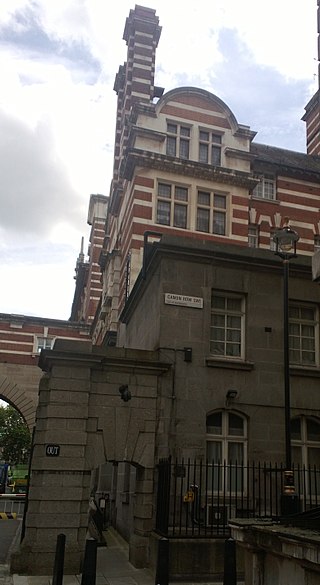
Canon Row Police Station in Canon Row, Westminster, was one of the Metropolitan Police's better known central London police stations. Replacing a leased station on King Street in St James's, it opened on 21 July 1902 in an extension to the Norman Shaw Buildings, then the home of New Scotland Yard. Canon Row Police Station was designed by the Metropolitan Police Surveyor, John Dixon Butler, with Richard Norman Shaw as consultant. The building is listed at Grade II*, and is no longer in use as a police station.

The Parliamentary Archives of the United Kingdom preserves and makes available to the public the records of the House of Lords and House of Commons back to 1497, as well as some 200 other collections of parliamentary interest. The present title was officially adopted in November 2006, as a change from the previous title, the House of Lords Record Office.
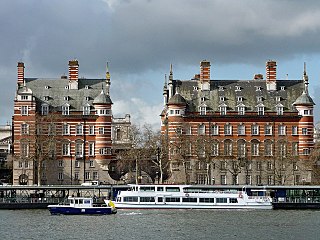
The Norman Shaw Buildings are a pair of buildings in Westminster, London, overlooking the River Thames. The buildings were designed by the architects Richard Norman Shaw and John Dixon Butler, between 1887 and 1906, they were originally the location of New Scotland Yard between 1890 and 1967, but from 1979, have been used as parliamentary offices and have been named Norman Shaw North and South Buildings, augmenting limited space in the Palace of Westminster.

Old Palace Yard is a paved open space in the City of Westminster in Central London, England. It lies between the Palace of Westminster to its north and east and Westminster Abbey to its west. It is known as the site of executions, including those of Sir Walter Raleigh, Guy Fawkes and other conspirators of the Gunpowder Plot, and James Hamilton, 1st Duke of Hamilton, following the Battle of Preston.

Richmond House is a government building in Whitehall, City of Westminster, London. Its name comes from an historic townhouse of the Duke of Richmond that once stood on the site.
The State Opening of Parliament includes a State Procession, a formal display of the Sovereign, dignified by a sizeable entourage made up of Great Officers of State and members of the Royal Household. The State Procession is now confined to the interior of the Palace of Westminster, but in earlier centuries it followed an outdoor route to and from Westminster Abbey.

The Red Lion is a Grade II listed public house at 48 Parliament Street, London SW1. The pub is known for its political clientele and has been described as "the usual watering hole for MPs and parliament staffers" and "much-plotted-in" due to its proximity to UK political institutions including Whitehall, the Palace of Westminster, and 10 Downing Street.

New Scotland Yard, formerly known as the Curtis Green Building and before that, Whitehall Police Station, is a building in Westminster, London. Since November 2016, it has been the Scotland Yard headquarters of the Metropolitan Police (MPS), the fourth such premises since the force's foundation in 1829. It is located on Victoria Embankment and is situated within the Whitehall Conservation Area. It neighbours the Norman Shaw and Ministry of Defence buildings, together with Richmond House and Portcullis House.
Several parties have advocated the relocation of the Parliament of the United Kingdom from its current location at the Palace of Westminster, London, to the English Midlands or Northern England, for economic or other reasons. A contributing factor in favour of relocating the Parliament is the extremely high cost of any restoration programme.

Speaker's House is the official residence of the Speaker of the House of Commons, the lower house and primary chamber of the Parliament of the United Kingdom. It is located in the Palace of Westminster in London. It was originally located next to St Stephen's Chapel and was rebuilt and enlarged by James Wyatt in the early 19th century. After the burning of Parliament in 1834 it was rebuilt by Charles Barry as part of the new Palace of Westminster in the Perpendicular Gothic Revival style. It is located at the northeast corner of the palace and is used for official functions and meetings. Each day, prior to the sitting of the House of Commons, the Speaker and other officials walk in procession from the apartments to the House of Commons Chamber.
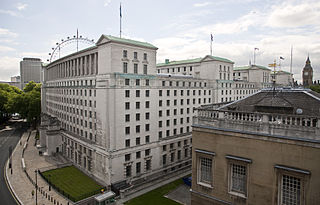
The Ministry of Defence Main Building or MOD Main Building, also known as MOD Whitehall or originally as the Whitehall Gardens Building, is a grade I listed government office building located on Whitehall in London. The building was designed by E. Vincent Harris in 1915 and constructed between 1939 and 1959 on part of the site of the Palace of Whitehall, specifically Pelham House, Cromwell House, Montagu House, Pembroke House and part of Whitehall Gardens. It was initially occupied by the Air Ministry and the Board of Trade before becoming the current home of the Ministry of Defence in 1964.
The history of the Palace of Westminster began in the Middle Ages – in the early eighth century – when there was an Anglo-Saxon church dedicated to St. Peter the Apostle which became known as the West Minster. In the tenth century the church became a Benedictine abbey and was adopted as a royal church, which subsequently became a royal palace in the 11th century.
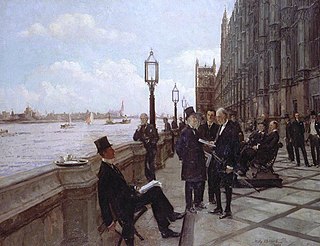
The Parliamentary Art Collection is a collection of around 8,500 artworks held by the United Kingdom Parliament. The works are jointly owned by the House of Commons and the House of Lords. Approximately 80% of the collection is displayed at the Palace of Westminster and associated buildings of the Parliamentary Estate nearby, but not government buildings in Whitehall, or Downing Street.


















